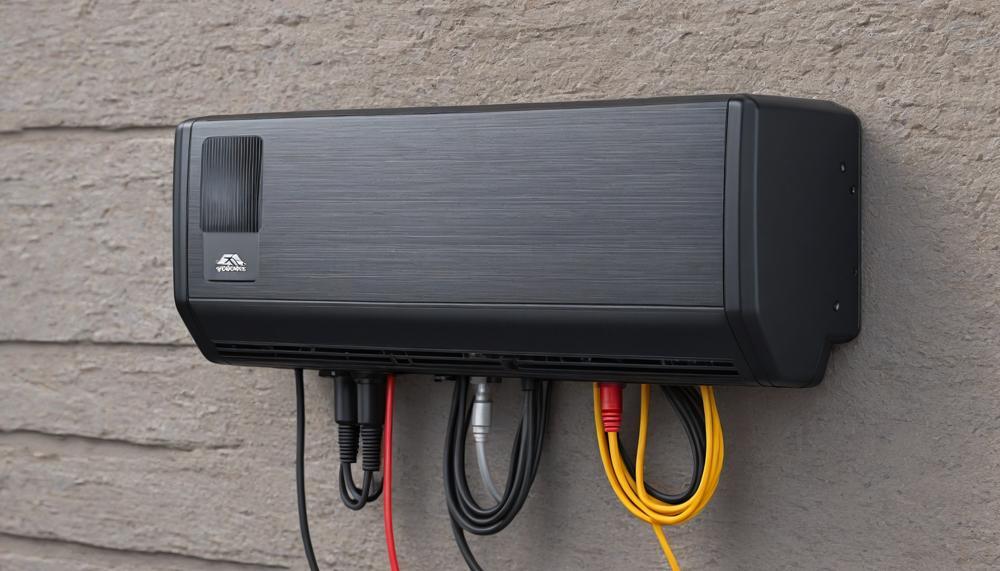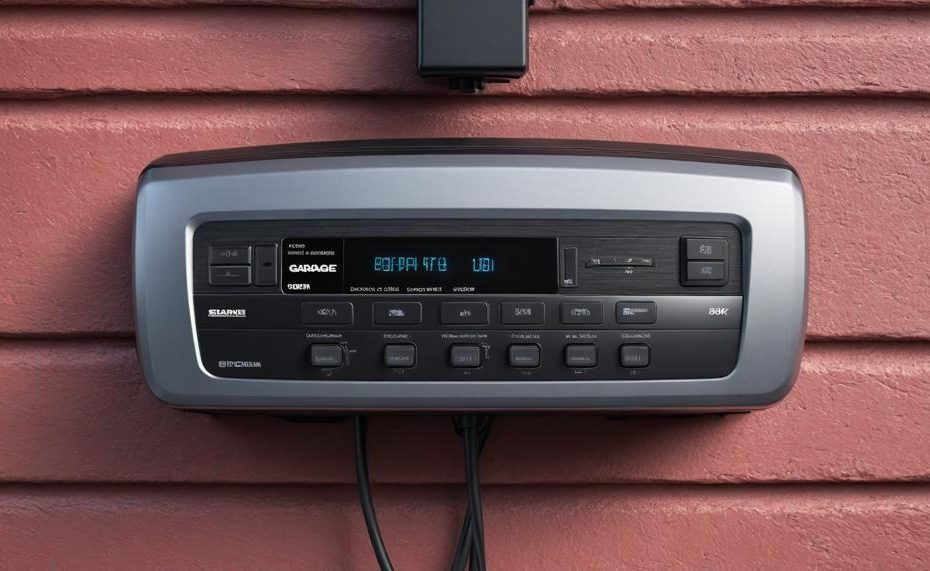Ever wondered how many amps your garage door opener uses? The answer is straightforward: a typical garage door opener uses between 2.92 and 5 amps. Knowing this is more important than you might think. It helps ensure your garage door operates smoothly without tripping your circuit breaker or causing electrical issues. Here’s why this knowledge is significant:
- Circuit Safety: Understanding the amperage helps in choosing the correct circuit breaker to avoid overloads.
- Electrical Planning: Helps in determining if additional devices can share the same circuit.
- Energy Efficiency: Garage door openers use minimal energy, with a 3/4 hp unit consuming about 4.6 kWh monthly.
Whether you’re installing a new opener or troubleshooting an existing one, knowing its amperage can save you from potential headaches and costly repairs. Stay tuned to learn more about optimizing your garage door opener’s performance and ensuring a safe, efficient setup.
Contents
- 1 How Many Amps Does My Garage Door Opener Use?
- 2 How to Determine the Amperage of Your Garage Door Opener
- 3 The Low Current Demands of Garage Door Openers Compared to Other Household Appliances
- 4 Wattage Rating and Power Requirements for Garage Door Openers
- 5 Recommended Breaker Size for Connecting a Garage Door Opener to a Circuit
- 6 Energy Consumption of Garage Door Openers and Its Impact on Electricity Bills
- 7 Factors That Can Affect the Amperage Usage of Your Garage Door Opener
- 8 Conclusion
How Many Amps Does My Garage Door Opener Use?
The typical amperage usage for a standard garage door opener ranges from 2.92 to 5 amps. This variance is influenced by the specific model and features of the garage door opener. Understanding the amperage is vital to ensure proper circuit installation and to prevent electrical issues.
| Model | Amperage Usage (Amps) | Power Rating (Watts) |
| Basic 1/2 HP | 2.92 – 3.5 | 350 – 420 |
| Standard 3/4 HP | 3.5 – 4.5 | 420 – 540 |
| Advanced 1 HP | 4.5 – 5.0 | 540 – 600 |
How to Determine the Amperage of Your Garage Door Opener
To determine the amperage of your garage door opener, follow these steps:
Check the Manufacturer’s Label
Locate the label on your garage door opener, typically found on the motor unit. This label provides critical information such as the model number, voltage, wattage, and sometimes the amperage.
Calculate Using Wattage and Voltage
If the amperage is not listed, you can calculate it using the formula:
[ \text{Amperage (A)} = \frac{\text{Wattage (W)}}{\text{Voltage (V)}} ]
For example, if your garage door opener is rated at 600 watts and operates on 120 volts:
[ \text{Amperage} = \frac{600}{120} = 5 \text{ amps} ]
Use a Clamp Meter
For a precise measurement, you can use a clamp meter. This device clamps around the power wire of the garage door opener and measures the current draw directly. Ensure to follow the device’s instructions for accurate readings.
Consult the User Manual
The user manual for your garage door opener often contains detailed specifications, including the amperage. Check the electrical section for this information.
| Step | Description | Notes |
| Check the Manufacturer’s Label | Locate the label on the motor unit for specifications. | Includes model number, voltage, wattage, and sometimes amperage. |
| Calculate Using Wattage and Voltage | Use the formula: Amperage = Wattage / Voltage. | Example: 600W / 120V = 5A. |
| Use a Clamp Meter | Measure the current draw directly using a clamp meter. | Follow the meter’s instructions for accurate readings. |
| Consult the User Manual | Check the manual for detailed electrical specifications. | Often found in the electrical section. |
The Low Current Demands of Garage Door Openers Compared to Other Household Appliances
The low current demands of garage door openers set them apart from other household appliances.
Garage door openers typically consume much less electricity compared to high-demand appliances like air conditioners, refrigerators, or electric ovens. This makes them more energy-efficient and cost-effective for homeowners.
Comparative Analysis of Current Demands
| Appliance | Average Power Consumption (Watts) | Estimated Monthly Cost |
| Garage Door Opener | 100 – 200 | £0.60 – £1.20 |
| Refrigerator | 150 – 300 | £5.40 – £10.80 |
| Air Conditioner | 2000 – 5000 | £72 – £180 |
| Electric Oven | 2000 – 5000 | £30 – £75 |
| Washing Machine | 500 – 1500 | £4.50 – £13.50 |
Why Garage Door Openers Are Energy Efficient
- Intermittent Use: Unlike refrigerators and air conditioners that run continuously, garage door openers operate for short periods, resulting in lower overall energy consumption.
- Low Standby Power: Modern garage door openers are designed to minimize standby power usage, making them even more efficient when not in active use.
- Energy-Saving Features: Some models come with energy-saving features such as LED lights and efficient motors, further reducing their power consumption.
Practical Implications
For homeowners looking to reduce their energy bills, focusing on appliances with high power consumption is crucial. Although garage door openers use less power, ensuring they are modern and well-maintained can contribute to overall energy savings. Opting for energy-efficient models can also help in reducing the household’s carbon footprint.
Wattage Rating and Power Requirements for Garage Door Openers
Garage door openers typically require varying wattage ratings and power requirements depending on their design, size, and functionality. Understanding these requirements helps in selecting the right opener for your garage, ensuring efficiency and reliability.
Wattage Ratings and Power Requirements for Garage Door Openers
Common Wattage Ratings
Garage door openers generally range between 200 to 600 watts. Here’s a breakdown based on types:
| Type of Garage Door Opener | Average Wattage | Notes |
| Chain Drive | 500-600 watts | Most powerful, suitable for heavy doors. |
| Belt Drive | 400-500 watts | Quieter operation, ideal for attached garages. |
| Screw Drive | 200-300 watts | Less maintenance, moderate noise level. |
| Direct Drive | 150-200 watts | Lowest noise, minimal maintenance. |
Power Requirements
- Voltage: Most residential garage door openers operate on a standard 120V outlet. Some higher-end models might require a 240V outlet, particularly for larger or more complex systems.
- Current Draw: Typically, garage door openers draw between 1 to 5 amps during operation. It’s important to ensure that the electrical circuit can handle this load to avoid tripping breakers.
- Standby Power: Modern garage door openers with smart features and battery backups consume additional power in standby mode, usually around 5 to 10 watts.
Energy Efficiency
Opt for garage door openers with an energy-efficient motor and LED lighting to reduce overall power consumption. Models with DC motors are generally more energy-efficient compared to those with AC motors.
Additional Considerations
- Installation: Proper installation is crucial for efficient power usage. Ensure the opener is installed according to the manufacturer’s specifications.
- Maintenance: Regular maintenance can prevent excess power usage. Keep the tracks clean and lubricated, and check for any obstructions.
Recommended Breaker Size for Connecting a Garage Door Opener to a Circuit
The recommended breaker size for connecting a garage door opener to a circuit is 15 amps. Garage door openers typically draw a small amount of current, generally between 5 to 7 amps. A 15-amp circuit breaker provides sufficient capacity to handle the startup surge and normal operation of the opener, along with any additional small devices that might share the circuit.
Garage door openers are relatively low-power devices, but they do require an appropriate breaker size to ensure safety and reliable operation. Here’s a breakdown of why a 15-amp breaker is recommended:
Current Draw and Startup Surge
- Normal Operation: Most garage door openers draw between 5 to 7 amps during regular use.
- Startup Surge: When the opener starts, it may momentarily draw higher current, potentially up to 10 amps or more.
Breaker Sizing
- 15-Amp Breaker: This size is sufficient to handle both the normal operating current and the startup surge without tripping.
- Dedicated Circuit: If the opener shares the circuit with other devices, the combined load should not exceed 80% of the breaker’s capacity (i.e., 12 amps for a 15-amp breaker).
Installation Considerations
- Wiring: Use 14-gauge wire (minimum) for a 15-amp circuit to ensure it can handle the current load.
- Code Compliance: Always check local electrical codes and regulations, as they may have specific requirements for garage door opener circuits.
Safety and Performance
Using the correct breaker size is crucial for the safety and longevity of your garage door opener. An undersized breaker can cause nuisance tripping, while an oversized breaker poses a fire risk if the wiring overheats.
| Breaker Size | Wire Gauge | Usage Notes |
| 15 Amps | 14 Gauge | Sufficient for typical garage door openers; allows for startup surge and normal operation. |
| 20 Amps | 12 Gauge | Not usually necessary for garage door openers; may be used if the circuit shares heavy loads. |
Energy Consumption of Garage Door Openers and Its Impact on Electricity Bills
Garage door openers might not be the first thing that comes to mind when thinking about energy consumption, but they can have a noticeable impact on electricity bills. Here’s a detailed look at how their usage translates to energy costs.
Energy Usage of Garage Door Openers
The energy consumption of garage door openers varies by model and usage patterns. On average, a garage door opener uses between 100 and 200 watts during operation and about 4 to 5 watts in standby mode.
| Operation Mode | Average Power Consumption | Duration of Use |
| Active (Opening/Closing) | 100-200 Watts | Approximately 2 minutes per cycle |
| Standby | 4-5 Watts | 23 hours and 56 minutes per day |

Cost Calculation
To estimate the monthly cost of running a garage door opener, consider the following:
- Active Usage: Assume the garage door is used 4 times a day.
- Standby Power: The door remains in standby mode for the rest of the day.
Using the average power consumption:
- Active Usage: (200 \text{ Watts} \times 4 \text{ uses/day} \times \frac{2}{60} \text{ hours/use} = 2.67 \text{ kWh/month})
- Standby Usage: (5 \text{ Watts} \times 24 \text{ hours/day} \times 30 \text{ days/month} = 3.6 \text{ kWh/month})
Total monthly consumption = (2.67 + 3.6 = 6.27 \text{ kWh}).
With an average electricity cost of $0.13 per kWh, the monthly cost is:
[ 6.27 \text{ kWh} \times 0.13 \text{ USD/kWh} = 0.82 \text{ USD/month}]
Energy Efficiency Tips
To reduce the impact of garage door openers on your electricity bill:
- Unplug the Opener: When away for extended periods, unplug the garage door opener to eliminate standby power consumption.
- Upgrade to a More Efficient Model: Newer models often have lower standby power consumption.
- Regular Maintenance: Ensure the door moves smoothly to avoid unnecessary strain and excessive power use.
Factors That Can Affect the Amperage Usage of Your Garage Door Opener
Several elements can impact the amperage consumption of your garage door opener, ranging from mechanical aspects to environmental conditions. Understanding these factors can help you maintain your opener efficiently and prevent potential issues.
Motor Size and Type
The motor’s size and type play a crucial role in determining amperage usage. Larger motors generally consume more amps.
AC motors might use more power compared to DC motors, which are often more energy-efficient.
Load Weight
The weight of the garage door significantly affects amperage draw. Heavier doors require more effort to lift, increasing the current the motor needs.
Regularly lubricating the door’s moving parts can reduce this load.
Door Balance
An unbalanced garage door can cause the motor to work harder, thus using more amperage. Ensuring the door is properly balanced can help in maintaining efficient operation.
Temperature
Extreme temperatures can impact the amperage usage. Cold weather can cause the door and its components to stiffen, requiring more power to operate. Conversely, very high temperatures might affect the motor’s efficiency.
Age and Condition of the Opener
Older garage door openers tend to use more power due to wear and tear.
Components like springs and rollers can deteriorate over time, increasing the motor’s load and amperage usage.
Frequency of Use
Frequent use of the garage door opener can lead to higher amperage consumption.
Motors can heat up and become less efficient with repeated use, especially in a short period.
Voltage Supply
The voltage supply in your home can affect the amperage draw.
A lower voltage supply will cause the motor to draw more current to perform the same amount of work.
Maintenance
Regular maintenance can help in keeping the amperage usage in check.
Ensuring that all parts are in good condition and the opener is clean can prevent unnecessary strain on the motor.
Conclusion
Understanding the amperage usage of your garage door opener, which typically ranges from 2.92 to 5 amps, is essential for maintaining a safe and efficient home setup. This knowledge ensures your opener operates smoothly without tripping circuit breakers or causing electrical issues. By selecting the right circuit breaker, you prevent potential overloads and ensure the opener is compatible with your electrical system.
Accurate amperage awareness also aids in efficient electrical planning. For example, a standard 3/4 horsepower unit consumes about 4.6 kWh monthly, making it an energy-efficient addition to your home. Knowing the specific amperage of your opener, whether it’s a basic 1/2 HP or an advanced 1 HP model, helps you manage the overall power consumption and electrical load of your household.
When installing or troubleshooting a garage door opener, always check the manufacturer’s label, use calculation formulas, or employ a clamp meter to measure the current draw. These steps ensure you’re well-informed about the power requirements, preventing future electrical problems and promoting a reliable and safe garage door operation.





